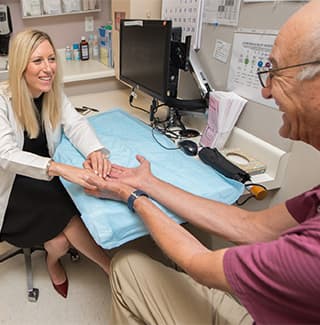What are the signs of arthritis in the hands?

Achy, swollen hands? Stiffness in your wrists? It’s common to assume these are symptoms of arthritis. While 40 million Americans suffer from arthritis, it’s far less frequent in the hands than people expect. Instead, what many mistake for arthritis is actually tendonitis. Let's look at the difference between arthritis and other conditions, risk factors and treatments.
Is it arthritis in my hand or tendonitis?
Arthritis and tendonitis can mimic each other, so it’s important to understand the difference between the two. Tendonitis is inflammation of the tendons in your hand due to an injury or repetitive motion, and the pain can come and go suddenly or last for a few days.
Arthritis, however, is inflammation of the joint due to degenerative joint disease. There are many types of arthritis, but the most common forms are osteoarthritis (OA), when the protective cartilage in the joint breaks down, and rheumatoid arthritis (RA), when immune system attacks the joints. Early symptoms of arthritis include painful hand joints, burning sensation and decreased functionality of the hand and/or wrist.
Types of arthritis in the hand
Fingertip Joint Arthritis
About 10% of people develop hereditary arthritis in the joints of the fingertips, also called the distal interphalangeal joints.
Putting pressure on our fingertips it’s similar to the amount of pressure we put through our knees when we’re walking. Because of this, its common to get patients with little nubby bumps on their fingers, called Heberden’s nodes, which are actually small bone outgrowths. These bumps rarely need to be treated unless it is impacting their mobility.
Basal Thumb Arthritis
Nearly 25% of women over the age of 50 develop arthritis in the thumb. That figure jumps to more than 50% for women over the age of 70. Because men seldom suffer from thumb arthritis, we believe that the ligaments that hold the joint together have estrogen receptors in women. After 50, when women lose their estrogen throughout menopause, the ligaments stretch out and the joint degenerates.
Post-Traumatic Arthritis
Post-traumatic arthritis is a form of osteoarthritis that occurs after a joint injury, but because arthritis develops gradually, it is hard to pinpoint when the condition began.
For example. we see a lot of arthritis in the wrist due to undiagnosed fractures, particularly a scaphoid or undiagnosed ligament injury. With injuries like this, it is hard to recognize arthritis early because it can take 8 to 10 years or more before we identify it, which is why it’s common at ages 45 to 60.
The wrist is prone to arthritis because there are no muscle or tendon attachments to the eight bones in the wrist, which means there isn’t much protection from everyday wear and tear.
Symptoms of Arthritis in Hands
Symptoms differ slightly depending on the type of arthritis you have, but these differences can help us determine the correct underlying cause. Common symptoms include:
- Pain in the hands and fingers
- Swelling in your hand/wrist joints
- Stiffness in your joints and hands
- Weakness in your hands
Diagnosing Arthritis in Hands
Accurately diagnosing hand arthritis can be complicated, so having a physical examination cannot always provide enough information. We can recommend an X-ray so we can pinpoint the hand arthritis and identify what stage it is in.
Treatment for Arthritis in Hands
UChicago Medicine hand and wrist specialists are at the forefront of complex surgical and non-surgical approaches for various conditions. We have developed techniques for ligament reconstructions and flexor tendon repairs that are now standard protocol across the country.
Non-Surgical Treatments
Depending on your individual diagnoses, there are a wide range of non-surgical options available to decrease pain and improve dexterity. Common non-surgical treatments include:
- Lifestyle changes, such as using exercise to improve mobility
- Medication to address inflammation and pain
- Reducing swelling and pain by regularly applying ice
- Bracing or splinting to decrease pain and increase function
- Steroid injections for symptom relief
Surgical Treatments
When non-surgical treatments do not relieve your pain or improve hand mobility, it may be time to consider surgical options. Our orthopaedic surgery team will help you understand when surgery is the right solution for you and what procedure would best meet your needs and healthcare goals. Common surgical procedures include:
Joint Replacements
Joint replacement is an option for patients who experience consistent pain due to a damaged and/or abnormal joint. During a replacement, the joint that is causing the pain is removed and a joint implant is inserted in its place. The implant can allow you to maintain joint motion and functionality without pain. Our hand specialists will help you decided if this is the right option for you.
Joint Fusions
With joint fusions, rather than replacing the joint, we create a stable and pain free joint by fusing the bones together. Joint fusions will relive pain but you may lose some motion. Our team will work with you to decide if this treatment will meet your health care goals.
Partial Joint Fusions
Partial joint fusions are limited to patients with degenerative wrist arthritis. During partial joint fusions, the small bones of the wrist are fused together, which alleviates pain while still retaining some wrist mobility. If you have degenerative wrist arthritis, this might be the treatment that best suits your needs.

Jeffrey G. Stepan, MD, MSc
Jeffrey G. Stepan, MD, MSc, is a highly skilled orthopaedic hand and upper extremity surgeon specializing in the treatment of traumatic injuries and atraumatic conditions of the hand, wrist, and elbow in adult and pediatric patients.
Learn more about Dr. Stepan
Hand and Wrist Care
UChicago Medicine orthopaedic experts include recognized leaders in the treatment of hand and wrist injuries through nonsurgical and surgical techniques. Our goal is simple, to relieve any pain and discomfort so we can restore your strength, motion, dexterity, form and function.
Learn more about our hand and wrist services.